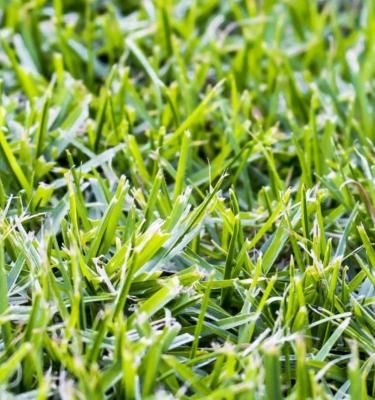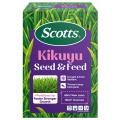

The Ultimate Guide to Caring for your Kikuyu Lawn
Kikuya grass, or Pennisetum Clandestinum, is a vigorous plant often used in Australian lawns and common in public recreational spaces. It thrives in warm, sunny climates but will also withstand very cold, frosty conditions. It is low cost to install, can be sown all year round, and provides ground cover throughout the seasons.
How to identify kikuyu grass
Kikuyu grass is a thick, densely growing plant which can produce an attractive evergreen lawn. The coarse flat leaves are typically 4-5mm wide with pointy tips. The grass tends towards upright growth with a thick mat of horizontal fleshy stems on the soil surface.
Kikuyu is an excellent choice for areas prone to drought and coastal conditions where the soil may be wind-dried and salty. A Kikuyu lawn will tolerate extreme weather better than most other varieties of grass, enjoying exposure to full sun and being resistant to frost damage. It is only moderately shade tolerant, so if your yard is a shady spot, consider a Buffalo grass instead.
Another big advantage of Kikuyu grass is its resilience. It is particularly well suited to areas of heavy use, as it can quickly recover from excessive footfall. It is often used on sports pitches and in parks, and so is perfect to install in a busy family garden.
The regenerative nature and rapid growth of Kikuyu also means it can become an aggressive weed if it is allowed to spread beyond the lawn. It will easily crowd out other plants if not contained, as the grass runners will creep across the soil to reach new areas. The roots are also thick and fibrous and will help this vigorous plant to spread. This can be managed with good preparation and regular care.
What you'll need to grow Kikuyu Lawn
A Kikuyu lawn should be installed in an open space that has lots of exposure to the sun. The soil will ideally be sandy and moist, as the plant performs well in humid conditions.
Kikuyu can be installed as turf or from seed. Turf is more expensive, whereas seed is cheaper but will take longer to provide a ready-to-use lawn. Whichever you opt for, make sure to choose a modern variety which is less likely to self-seed into nearby borders. Scotts Lawn Builder™ Seed & Feed Kikuyu Lawn Seed is a perfect blend of seed which will keep the young grass fed whilst it establishes in your yard. When purchasing the required amount of seed, aim for about 28g per square meter of lawn.
If you are laying the Kikuyu lawn yourself, you will need a rake and roller. Use these to help you to level the area and reduce air pockets in the soil. Otherwise, find an experienced, professional landscaper to help establish the lawn for you.
It is recommended that you install deep and solid lawn edging to stop Kikuyu grass reaching garden beds. Kikuyu is an invasive grower, and preparing to contain it in this way will reduce the need for heavy work digging out any grass that has gone beyond the lawn area.
How to install Kikuyu lawn
A Kikuyu lawn can be installed at any time of year, but from seed it is best done from early spring through to early autumn. The soil temperature should be above 21C (70F) to maximise germination rates of Pennisetum Clandestinum.
Prepare your new Kikuyu lawn space by installing edging along neighbouring beds to stop Kikuyu spreading too quickly. This will take time and effort now, but will save a lot effort when maintaining the lawn in future. Kikuyu roots extend far below the soil surface, and the edging will not stop them completely, but will help. Leave a 2” (5cm) lip of edging above the soil to stop the stolons spreading across the surface.
Dig the soil and remove any weeds using a weed killer for Kikuyu lawn, then rake and roll to level the soil and produce an even surface. Use a sprinkler to water the area before sowing Kikuyu seed. Sow the seed evenly, aiming for approximately two handfuls of seed per square meter. Water the area again using a soft spray sprinkler, and keep moist until established. Within three weeks your Kikuyu lawn should have settled and can be mown for the first time.
Watch our video of simple tips about how to lay a new lawn.
Kikuyu grass maintenance
Kikuyu grass is easy to maintain but it does benefit from regular lawn care to keep it attractive. Mowing is an essential weekly task. It will keep the lawn looking attractive, help to thicken the Kikuyu grass and encourage new growth. Cut to as low as 1” (2cm) in winter. In hotter months when moisture is easily lost from the soil surface, and in shaded areas, let it grow a bit longer.
Watering is really important for a new Kikuyu lawn. This is for the first 2-3 weeks whilst it settles in and strengthens. Once established, this robust lawn will withstand long periods of drought, and irrigating it is only necessary for those seeking perfection.
An established Kikuyu lawn will benefit from fertilising with a feed containing high levels of nitrogen and phosphorus. Apply Scotts Lawn Builder™ Seed & Feed Kikuyu Lawn Seed in early Spring and early Autumn to encourage fresh, lush green grass growth. Alternatively Scotts Lawn Builder™ Premium Slow Release Lawn Fertiliser can be applied using Scotts Wizz Lawn Spreader, ensuring an even spread of lawn feed.
Common kikuyu lawn problems, pests & diseases
A Kikuyu lawn is largely problem free, and issues can usually be prevented with a regular weed and feed. The main challenge with Kikuyu is containing it to the areas it is wanted, and stopping it from spreading elsewhere. There are not many pests or diseases which will cause significant damage to a Kikuyu lawn. Weeds are rarely a problem as the Kikuyu itself is a keen competitor and will usually crowd out other plants.
Why has my Kikuyu lawn become lumpy?
Kikuyu grass is prone to developing excess thatch at the soil surface. This is a mixture of living grass and old material. Kikuyu has such thick and lush growth that it can easily accumulate over a long period of time, forming hard clumps which eventually create an uneven lawn. Prevent this by collecting clippings after mowing, and using a lawn thatch rake to maintain a healthy surface.
Why is my kikuyu going yellow
Kikuyu does not cope well with shade, and will yellow if it does not receive enough direct sunlight. Even with good light, Kikuyu can take on a slightly yellow colour during the winter months, as the days are shorter and the plant does not produce so much chlorophyll, which gives the grass its vibrant green colour. This faint yellowing is a natural process and the plant will recover when longer days of sunlight return.
Why does my Kikuyu grass have yellow patches?
‘Kikuyu yellows’ is a fungal issue affecting grass roots. It appears as yellowing circles on the lawn, which will eventually result in dead patches of grass that are then taken over by weeds. Prevent this disease with regular feeding to keep the grass as healthy as possible. If you suspect Kikuyu yellows, collect clippings but do not compost them. Avoid walking on affected areas which can spread the disease.




